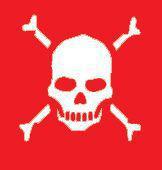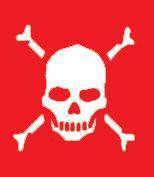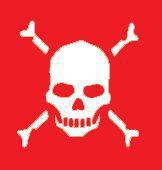SAS Urban Survival Handbook (67 page)
Read SAS Urban Survival Handbook Online
Authors: John Wiseman
Tags: #Health & Fitness, #Reference, #Survival, #Fiction, #Safety, #Self-Help, #Personal & Practical Guides, #General, #Survival Skills
REMEMBER
Even if you don’t know the meaning of the codes yourself, ALWAYS give them to the emergency services when alerting them to a fire or accident. Doing so may save seconds—or lives!
Most hazchem codes are made up of two or three characters. The first is usually a number which denotes the type of fire-fighting or controlling agent to be used:
1
= Water
2
= Water fog
3
= Foam
4
= Dry agent
The first letter indicates the type of dangerous substance which is involved, what precautions must be taken and whether or not the toxicity of the substance means that all spillages must be contained. Where
dilute
is indicated, the residue may be washed away to drains. The instruction to
contain
implies that it is important to prevent chemicals reaching drains or watercourses.
Where
E
is shown, people should be evacuated from the building or the vicinity of the incident. There may be other better-known symbols or whole words included—
CYLINDERS
indicates the risk of a serious explosion.
Care at work
Chemicals such as mercury compounds were once used in the millinery trade. These have been known for some time to damage the brain, to produce ‘mad hatters’. In many cases, such as this, the dangers were recognized too late.
The effects of chemicals are frequently cumulative—they build up in the blood and may cause disability or even cancer later in life. If your work involves handling any potentially hazardous substances or inhaling fumes or airborne particles, you should ensure that proper provision is made for your protection.
Protective clothing is only one element to consider. Methods which control and/or contain the hazard at source are the first requirement and proper ventilation is essential (see DIY/ CRAFT HAZARDS:
Protective clothing
).
The storage and handling of flammable, explosive, caustic and toxic materials, especially liquids and gases, is another obvious area where strict safety measures are required.
Graphic designers/illustrators
Spray glues are commonly used—although steps have been taken to discourage such substances. The main dangers are from the solvents employed (see POISONS:
Solvents
). Although these aerosol glues allow for fast working methods, the breathing of solvent vapours and glue particles has been proven to cause respiratory disorders. Other symptoms which may indicate inadequate ventilation are: headaches, nausea, short-term memory loss and dermatitis. Long-term effects may be far more serious—involving heart and liver damage and cancers.
Airbrushes—devices which atomize paints, inks and dyes—are also common. Many pigments are HIGHLY dangerous, especially when inhaled or ingested (see DIY/CRAFT HAZARDS:
Artists’ paints
).

WARNING
NEVER put paintbrushes in your mouth to ‘put a point on them’. Depending on the types of pigment involved, the cumulative effects could be extremely harmful—even fatal. The most dangerous pigments include almost all metal/metal oxide colours and lamp black. Aniline dyes are also poisonous.
Adequate and specialized ventilation systems or special spray booths should be used for better spray glues and airbrushes. Comfortable breathing protection would be sensible. The alternatives to spray glues include special adhesive waxes which are relatively safe for long-term use.
SOLVENT RISKS
Many shoe repair and dry-cleaning shops may have insufficient ventilation. Shoe repairs commonly involve the use of powerful solvent-based adhesives. Dermatitis is an extremely common side effect, also caused by the leather dyes and polishes, but there are far more serious risks from constant inhalation of solvent vapours. Dry-cleaning solvents are equally toxic. Short-term effects may include headaches, nausea and memory loss. Long-term effects may involve heart and liver problems and cancers (see DIY/CRAFT HAZARDS and POISONS).
REMEMBER
You MUST understand the dangers of dealing with chemicals on a long-term basis (see also SAFETY FIRST and DIY/CRAFT HAZARDS):
- ◑
MAKE SURE you know what to do in the event of any accident with chemicals – spillages may combine together to produce toxic or dangerous effects - ◑
NEVER transfer chemicals from original marked containers to improvised bottles and jars - ◑
NEVER leave containers open - ◑
MAKE SURE all containers are labelled correctly and clearly - ◑
NEVER use chemicals from indistinctly-labelled containers - ◑
BE TIDY! BE SAFE! Clear up spills as advised and dispose of as directed. Disposal information MUST be available to you
DISEASES/DISORDERS
For centuries, it has been known that workers in certain industries and occupations were prone to particular diseases and disorders. Coal miners and quarrymen were often stricken by the lung diseases pneumoconiosis and silicosis.
There are many other trades in which the risk of illness, injury or early death was the price for being in work. Today, an increasing number of hazards are now being recognized which were previously ignored or not understood.
▶ Additional information on safety in the work area and protective clothing can be found in DIY/CRAFT HAZARDS.
Dusts of many kinds, including metals, woods, minerals and even flour, may seriously damage health—affecting lungs, nose, throat, eyes, skin, digestive and urinary systems, the brain and nervous systems (see, for instance, DIY/CRAFT HAZARDS: Wood dust). Wear the correct level of breathing protection.

WARNING
Mineral oils!: All kinds of mineral oil, from bitumen and petroleum to paraffin and lubricants, present health risks. Most common problems are acne and dermatitis, but there are also risks of cancer and of respiratory problems from inhalation of fumes and particles. Cutting oils – usually formed by mixing a lubricating oil with animal or vegetable fats and other additives, present a particular risk – especially when unrefined. Some machine operators may be continually exposed to or splashed by such oils. A man straddling or rubbing against a machine may become oil-soaked. The scrotum is particularly susceptible to contamination and there is a great possibility of cancer. Women can also develop genital cancer from contact with mineral oils. NEVER keep oily rags in a trouser pocket. ALWAYS wash your hands free of oil BEFORE going to the lavatory.
REMEMBER
The warning above is just one example of a serious work hazard—do you know all the risks associated with your occupation?
It’s up to you!
Take a look at your colleagues at work—especially older ones who have been doing a job for many years. Do many of them show similar health problems? Those who do may have been heavy smokers or have other similarities that make them more prone to diseases—but could their problems be work related? Will the same things happen to you if you continue to work in the same way?
When people have ‘always done it this way and it’s never done me any harm’, they may be being blind to the obvious.
▶ Additional information on safety in the work area and protective clothing can be found in DIY/CRAFT HAZARDS.
If there is a chance your job puts you at risk, are there ways in which you could change working methods or conditions to make it safer? If you feel the risk is unavoidable, is it really worth it? Would it be better to look for something safer? You may not have many choices of occupation but, if people refuse to do unhealthy jobs, eventually the employers may be forced to make the jobs safer.
PHYSICAL DAMAGE
Many jobs, especially those involving manual work, place physical stress on the body and can cause damage to it, quite apart from accidental injuries. Those at risk range from construction workers to teachers, nurses to hairdressers, shop assistants to computer operators. Common causes of injury are:
- ◑ Bad posture
- ◑ Physical strain
- ◑ Vibration
- ◑ Repetitive operations

WARNING
You don’t have to go out to work to suffer from work-induced illnesses and disorders. Domestic chores can involve the same strains and cause the same problems and stresses.
Home workers and freelances should be particularly aware of the dangers of their jobs and the stresses induced by poor work environments. They may develop bad work practices or take undue risks because they have no one else to alert them.
Accidents
Many jobs involve working with dangerous tools, fast-moving machinery or in perilous locations. Where appropriate, helmets, goggles or face masks, gloves and other protective clothing or safety harnesses s hould always be worn. Hair should NOT be worn loose and trailing parts of garments must be covered, so that they cannot catch in machinery. Safety guards on tools and machinery must be used, even if it is possible to work more quickly without them. A slight increase in productivity is not worth a damaged limb or a lost life.

WARNING
NEVER operate a machine unless authorized and trained to do so. NEVER attempt to clean or clear a blockage on a machine which is in motion or connected to a power source. SWITCH IT OFF AND DISCONNECT IT FROM THE POWER SOURCE.
NEVER wear loose clothing, long hair, dangling chains or other jewellery which could get caught up in moving parts. NEVER distract other people who are operating machinery.